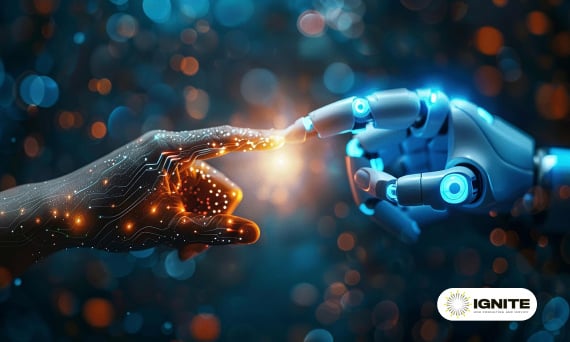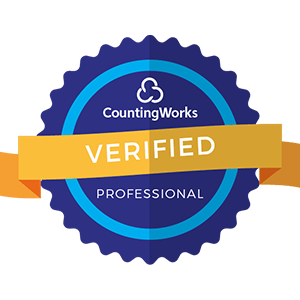
Picture this: It's 2030, and you're walking into your office (yes, some of us still do that). As you approach your desk, a holographic display pops up, greeting you by name and reminding you of your top priorities for the day. Meanwhile, in the HR department, an AI assistant is sifting through thousands of resumes, identifying the perfect candidates for a new position. At the same time, a human HR manager is having a heart-to-heart with an employee about their career aspirations.
Welcome to the future of Human Resources, where artificial intelligence and human intuition dance in perfect harmony. Sounds like science fiction? Think again. This future is closer than you might think, and it's reshaping the world of HR as we know it.
In this deep dive, we're going to explore how AI is revolutionizing HR, the challenges and opportunities it presents, and most importantly, how to strike the perfect balance between technological efficiency and the irreplaceable human touch. Buckle up, because the future of HR is a wild, exciting ride!

Before we jump into the future, let's take a quick look at where we are now. AI in HR isn't some far-off concept – it's already making waves in organizations around the world.
Here are just a few ways AI is currently being used in HR:
Mind-Bending Stat: According to a study by Oracle and Future Workplace, 50% of workers are currently using some form of AI at work, up from 32% in 2018. The AI revolution isn't coming – it's here!
But this is just the tip of the iceberg. As we look to the future, the potential applications of AI in HR are both exciting and, let's face it, a little bit scary. But don't worry – we're here to guide you through it all.
As we peer into the crystal ball of HR's future, several trends emerge that promise to reshape the landscape of human resources. Let's explore some of the most exciting (and potentially disruptive) applications of AI in HR.
Imagine a world where every aspect of an employee's journey is tailored specifically to their needs, preferences, and potential. That's the promise of AI-driven personalization in HR.
How it might work:
The human touch: While AI can provide incredible personalization, human HR professionals will be crucial in interpreting the AI's recommendations and adding the nuanced understanding that comes from real-world experience and emotional intelligence.
The ability to predict future workforce needs with a high degree of accuracy? It's not just possible – it's becoming essential.
How it might work:
The human touch: Human HR leaders will be vital in translating these predictions into strategic decisions, considering factors that may not be captured in data, such as company culture and long-term business strategy.
Say goodbye to annual performance reviews. The future of performance management is continuous, data-driven, and proactive.
How it might work:
The human touch: While AI can provide data-driven insights, human managers will be essential in delivering feedback, providing mentorship, and having those crucial development conversations that require empathy and understanding.
AI won't replace HR decision-makers, but it will make them superheroes.
How it might work:
The human touch: Human judgment, ethical considerations, and the ability to consider complex, non-quantifiable factors will be more important than ever in making final decisions.
While we may never completely eliminate bias, AI has the potential to significantly reduce its impact in HR processes.
How it might work:
The human touch: Human oversight is crucial to ensure AI systems don't perpetuate or create new biases. Regular audits and diverse teams will be essential in developing and maintaining these systems.

As we've seen, the future of HR isn't about AI replacing humans – it's about creating a powerful partnership between human intelligence and artificial intelligence. But how do we structure this partnership for optimal results? Enter the PAIR framework: Partnership, Augmentation, Integration, and Reflection.
In this stage, we recognize that AI and humans each have unique strengths and weaknesses. The goal is to create a true partnership where each complements the other.
AI's Strengths:
Human Strengths:
By partnering AI and human capabilities, we can create HR processes that are both efficient and empathetic, data-driven and nuanced.
Here, we focus on how AI can augment human capabilities, making HR professionals more effective and empowered.
Examples of Augmentation:
The key is to use AI to enhance, not replace, human judgment and intuition.
This stage is about seamlessly integrating AI into HR workflows and systems.
Keys to Successful Integration:
The goal is to make AI a natural, intuitive part of every HR professional's toolkit.
Finally, we must continuously reflect on and evaluate the impact of AI in HR.
Questions for Reflection:
Regular reflection ensures that we're using AI in ways that truly benefit both the organization and its people.
As we rush headlong into this AI-powered future, it's crucial that we pause to consider the ethical implications of these technologies. The decisions we make now will shape the future of work for generations to come.
With AI's ability to collect and analyze vast amounts of employee data comes significant privacy concerns.
Key Considerations:
Potential Solutions:
As AI systems become more complex, it can become increasingly difficult to understand how they arrive at their decisions. This "black box" problem poses significant challenges, especially in HR where decisions can greatly impact people's lives and careers.
Key Considerations:
Potential Solutions:
As AI becomes more prevalent in HR, there's a risk of creating a skills gap where many HR professionals aren't equipped to work effectively with these new technologies.
Key Considerations:
Potential Solutions:
Perhaps the most crucial ethical consideration is how to maintain the human element of HR in an increasingly AI-driven world.
Key Considerations:
Potential Solutions:

So, how do we prepare for this brave new world of AI-powered HR? Here's a roadmap to guide you on your journey:
Before you can move forward, you need to know where you stand.
Action Steps:
Don't just adopt AI for the sake of it. Develop a clear strategy that aligns with your organizational goals.
Action Steps:
Don't try to transform everything overnight. Start with pilot projects and scale based on lessons learned.
Action Steps:
Remember, the success of AI in HR depends on the people using it.
Action Steps:
Build ethical considerations into your AI strategy from the ground up.
Action Steps:
Successfully integrating AI into HR requires collaboration across the organization.
Action Steps:
The field of AI is evolving rapidly. Your approach needs to be flexible enough to evolve with it.
Action Steps:
As we stand on the brink of this AI revolution in HR, it's natural to feel a mix of excitement and apprehension. The potential for AI to transform HR processes, enhance decision-making, and create more personalized employee experiences is truly staggering. At the same time, the ethical challenges and the potential for AI to depersonalize HR are very real concerns.
But here's the thing: the future of HR isn't about choosing between AI and human expertise. It's about creating a powerful synergy between the two. AI can handle the heavy lifting of data processing and pattern recognition, freeing up human HR professionals to focus on what they do best – understanding and connecting with people, navigating complex emotional landscapes, and making nuanced decisions that consider factors beyond what can be quantified in data.
The HR professionals who will thrive in this new landscape won't be those who resist AI, nor those who blindly embrace it. Instead, they'll be the ones who learn to dance with AI – to work alongside it, to understand its strengths and limitations, and to use it as a tool to enhance their own uniquely human capabilities.
So, are you ready to step into the future of HR? It's a future where data-driven insights meet human intuition, where efficiency meets empathy, and where every employee can receive the personalized support they need to thrive. It's a future that's challenging, exciting, and full of potential.
The AI revolution in HR is here. The question is: how will you shape it?


